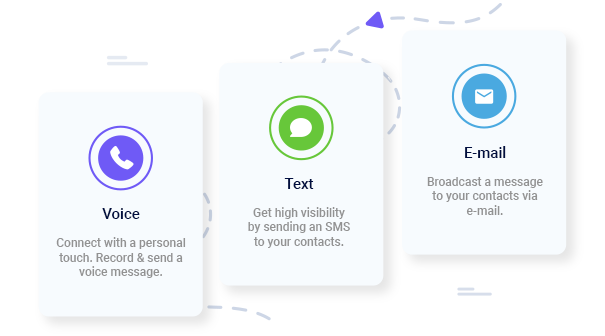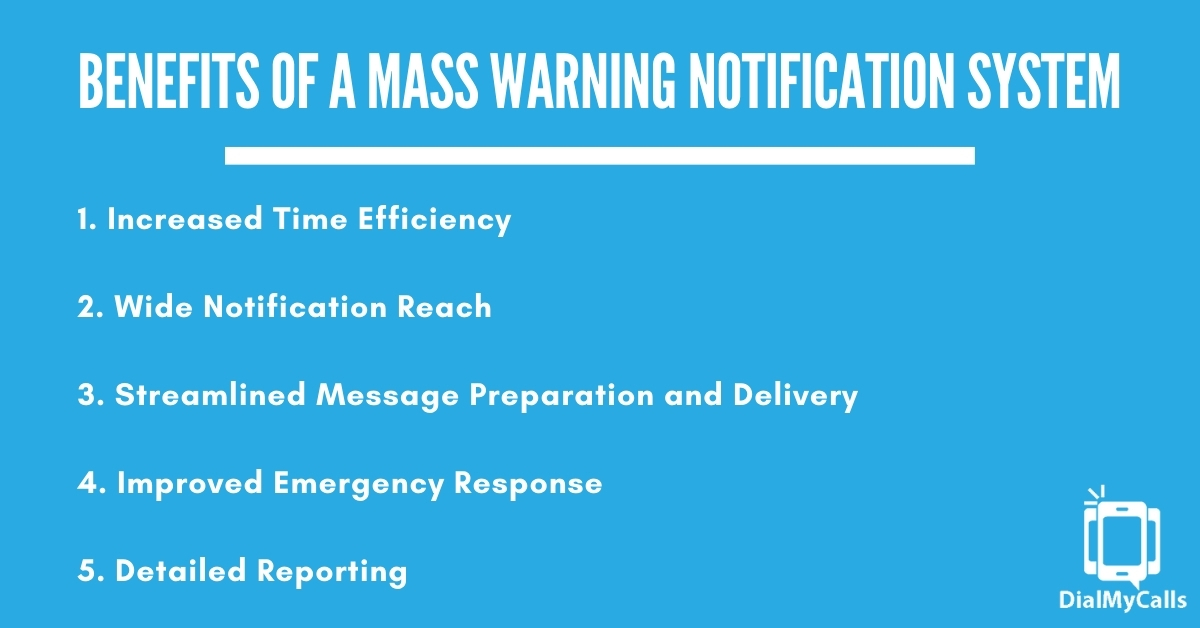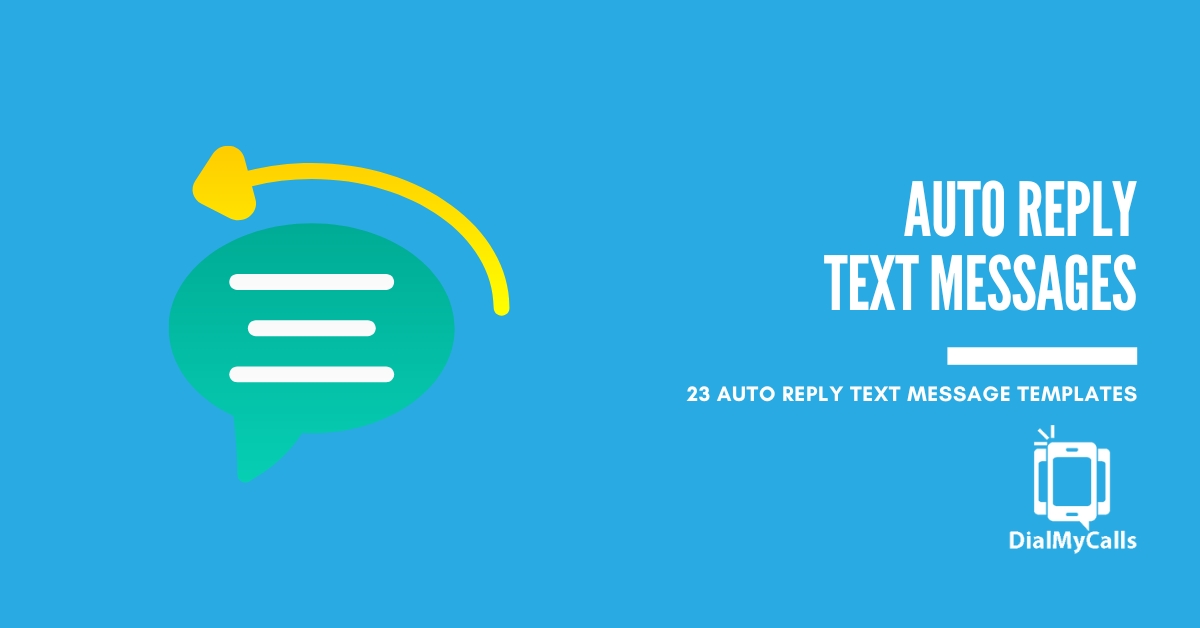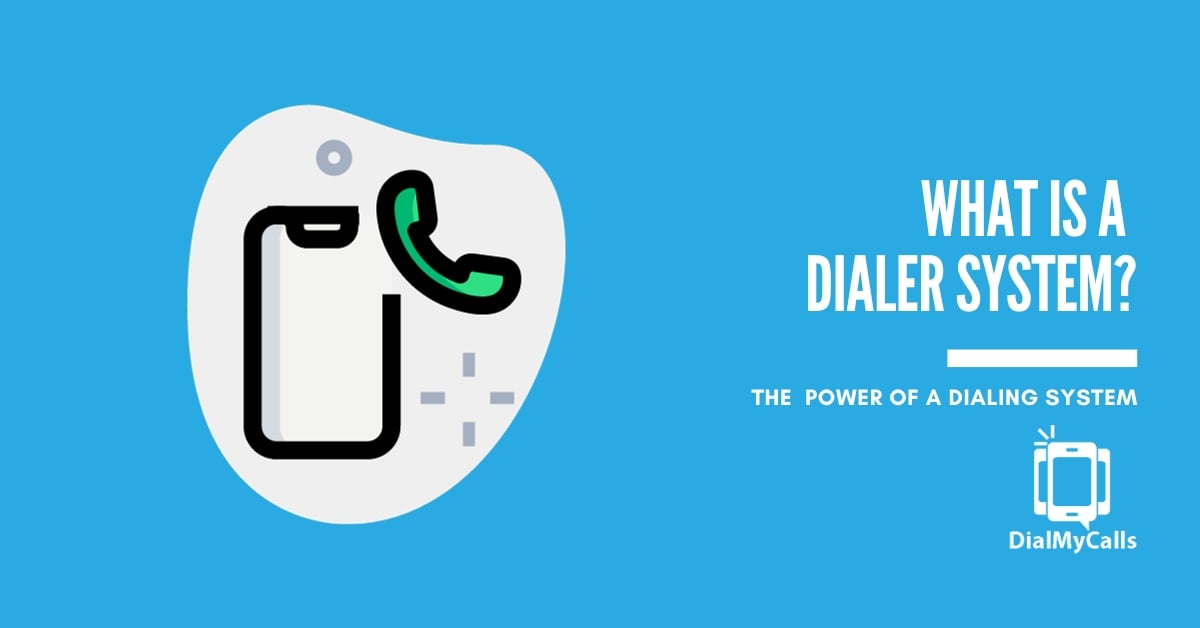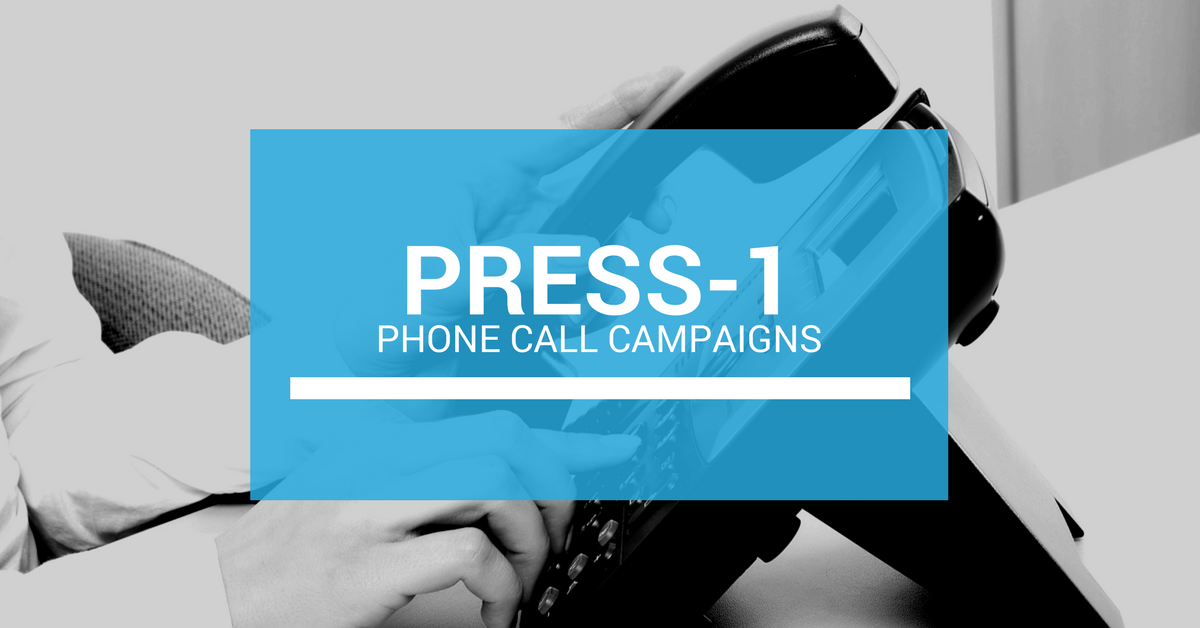What is a Mass Warning Notification System? (With Examples)
Posted by Tim Smith in Mass Notification System on January 15, 2024
Updated on February 28, 2024
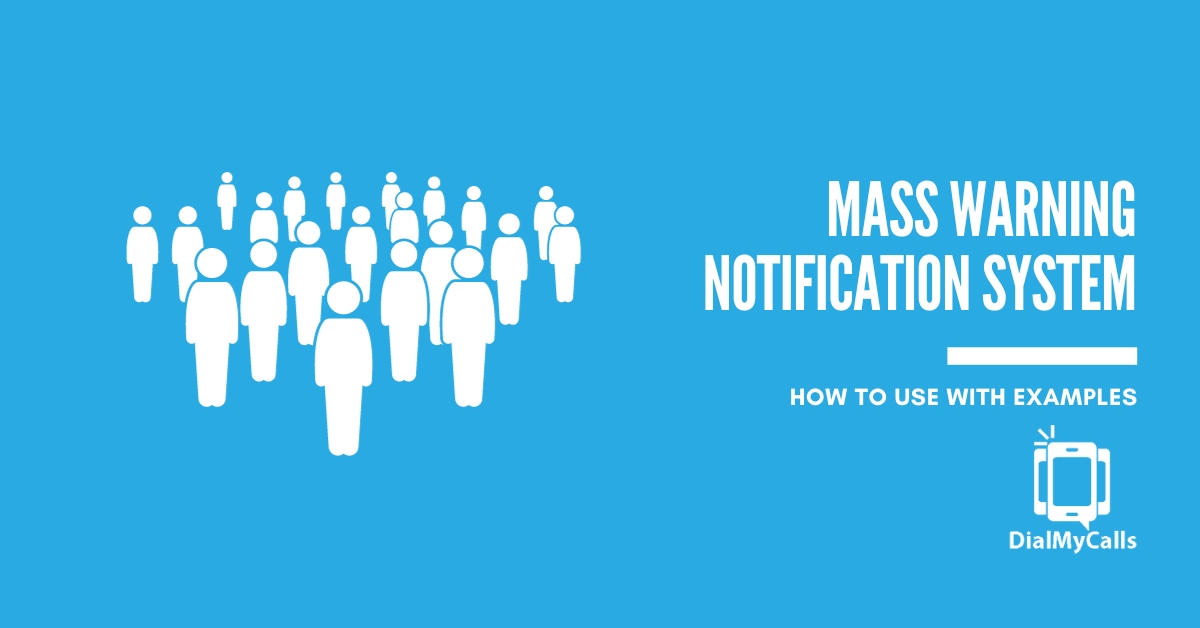
In emergency situations, especially those concerning numerous people, communication can be a major challenge. Aside from sorting out the situation, you must get important and possibly time-sensitive information to numerous people at once. This is where a mass warning notification system comes in.
Now, the benefits of this alert system extend beyond basic communication in emergencies, and here, we’ll explore each one. So, tag along as we discuss all about mass warning notification systems and how to set them up.
What Is a Mass Warning Notification System?
A mass warning notification system is a platform that enables you to send messages to numerous recipients simultaneously in emergencies. Also known as an alert mass warning notification system, this platform enables recipients to receive urgent warnings or alerts quickly.
Mass warning notification systems use calls, text messages, push notifications, desktop alerts, and even social media to alert recipients. Basically, they use any channel to connect the sender to the recipient so they can pass critical information in an emergency.
Look at the new cta now!
Sign Up For an Account Today!
This system sends your emergency text straight to your contacts, irrespective of how large your contact list might be. And they operate at an optimum speed, so messages reach the recipients within seconds.
Examples of Alert Mass Warning Notification System
Considering how important they are, it’s only expected for mass warning notification systems to be quite common. And, of course, each of these systems has its own specifications and unique features. So, if you’re looking to set up a mass warning notification system, here are a few examples to consider:
1. DialMyCalls
DialMyCalls is a mass notification service designed to send messages to numerous people simultaneously. With this platform, you can curate urgent notifications in the form of messages and send them either via SMS, email, or even voice calls.
Equipped with features like automated calling, bulk emailing, and mass texting, DialMyCalls can come in handy in emergencies. Not to mention, this mass warning notification system ensures the messages reach clients in absolutely no time at all.
Plus, DialMyCalls brags about a system adapted to send thousands of messages. So, no matter how large your contact list is, you don’t have to worry. Also, the platform seamlessly integrates with other services, thus making it more efficient and reliable.
2. Informacast
Informacast is an alert mass warning notification system that works with triggers to send messages to recipients in emergencies. You can use this platform in situations such as severe weather alerts, building lockdowns, and building evacuations.
With Informacast, you can also track your notifications and monitor their results. So, after the message gets to the recipients, you get to see who opened the notification or performed an action through it.
3. Alertmedia
offers a straightforward approach to sending messages in emergencies or urgent situations. With this emergency communication app, you can send messages through text messages, voice calls, or through a software application.
After curating your messages, Alertmedia also offers the option of sending them to people within a particular location.
Types of Mass Warning Notification System
Mass warning notification systems come in different forms, which you can apply in different situations. These warning notification systems fall into groups according to the kind of alerts they broadcast and what situations they suit. With that said, below, we’ll explore the types of warning notification systems:
1. Landline Mass Notification System
Essentially, a landline mass notification system sends alerts to the recipients through their landlines. This type of mass warning notification system works by recording the message on the sender’s end and transmitting it to the recipients.
Now, since this message transfer happens through a landline, the recipient must have a landline. However, few people use landlines nowadays, so the landline mass notification system isn’t very popular.
2. SMS Text Mass Notification System
The SMS text alert mass notification system, as the name implies, transmits alerts through SMS messages. So, as long as the recipient uses a smartphone and opts in to the service, they can receive notifications.
Now, among the types of warning notification systems, the SMS text alert system is one of the most effective. Statistically, SMS messages have an open rate of 98%. This means that almost everyone who gets text messages opens them.
To this effect, coupling fast delivery and high open rates, SMS texting offers versatility, flexibility, and efficiency in urgent situations.
3. Wireless Emergency Alerts (WEA)
Wireless Emergency Alerts are mass warning notification systems that transmit urgent messages to people’s wireless phones. This includes both mobile phones, tablets, and cordless phones.
Typically, alerts through this system come from the Federal Emergency Management Agency (FEMA) or other local authorities. The messages get to people within a specific geographical location.
4. Color Code Alert Systems
The color code alert system is a quick way of alerting people, especially in time-sensitive scenarios.
Common among hospitals and healthcare facilities, color code alert systems notify people about urgent situations using color codes. In this system, specific colors represent respective situations or how urgent the situation is. For example, code red means there’s a fire or a chance of a fire outbreak. It could also mean the situation must be attended to with urgency.
5. Organizational Emergency Mass Notification Systems
Organization emergency mass notification systems are suited according to the needs of specific companies. For this system to work efficiently, the company must have a contact list comprising all its employees’ contact information. This way, the company can easily send out mass emergency notifications to the employees simultaneously.
This system uses channels of message transmission like SMS messages, calls, or pre-recorded messages to send urgent messages to employees.
Benefits of a Mass Warning Notification System
The advantages of using a mass warning notification system are too many to count. From security assurance to increased time and cost efficiency, mass warning notification systems can save you a lot of trouble. Below are five benefits of a mass warning notification system:
1. Increased Time Efficiency
In an emergency, time efficiency is a key player in ensuring everyone gets critical information. Fundamentally, good time efficiency ensures that the recipients get the message in the least time possible so they can take action.
Mass warning notification systems help you increase the time efficiency of your messages. These systems work with fast message delivery media such as SMS and emails so the message reaches the recipient quickly. Plus, with push notifications, messages pop up on the recipient’s screen so that they can gauge its urgency even before opening it.
2. Wide Notification Reach
With mass warning notification systems, you can reach thousands of people within a matter of seconds. For smartphone-based alert systems, you don’t have to curate a message for each recipient. Instead, you can create a contact list and broadcast the message simultaneously across your contacts.
Additionally, there is a wide range of information media that you can use. From mass texting services to broadcast calls and recorded messages, mass alert systems enable you to send urgent messages through your recipients’ preferred media. Thus, there’s a higher chance that, alongside the wide reach, more people would read the message as well.
3. Streamlined Message Preparation and Delivery
Like every form of technology, mass warning notification systems have evolved. Now, these alert systems enable you to create message templates beforehand. So, in the case of an emergency, you don’t have to start from scratch while drafting the alert.
Also, you can schedule the notifications to alert your recipients of an upcoming occurrence. For example, if a building would be on lockdown at a particular time, you can schedule a message beforehand. After that, the system automatically sends the message without needing your manual assistance.
4. Improved Emergency Response
Another benefit of technological integration with mass warning notification systems is the introduction of two-way communication. This feature allows you to receive a response from the recipients after sending them a warning notification. Once the recipient can respond to your notification, they can communicate their state with you.
Now, this improved emergency response can come in handy in potentially dangerous situations. With two-way communication, you can find out if the recipient needs help or directions to escape a possibly unsafe environment.
5. Detailed Reporting
Modern mass warning notification systems also provide detailed reports after sending each batch of messages. These reports tell you how many people opened the notification and how successful the alerts were.
As such, you can compare various media for sending warning notifications to see which one is most successful. Hence, it leads to a more optimized alert and notification system.
How Does a Warning Notification System Work?
The working mechanism behind a warning notification system is simple, yet highly effective. Primarily, this mechanism is the linkage between the sender of a warning notification and the recipient.
Mass warning notification systems have a constant list where you can find all the contact details of recipients. This contact list is either compiled from entries by the recipients or the sender filling in the recipient’s details. From this contact list, the sender can group the recipients according to criteria such as work departments in an organization.
During a critical event or emergency, the sender either curates a message from scratch or fills out a prepared template. Then, they send it to a contact group or the whole contact list on the system, either through text, email, or audio.
Once the sender disperses the notifications, the mass warning notification system delivers the message to the recipients. The system could also escalate the notification to subsequent recipients if necessary.
What Are the Requirements for a Mass Notification System?
Before you choose to set up an alert mass warning notification system, you must ensure that it meets the standard requirements. The National Fire Protection Association (NFPA) established standards for the installation and use of fire alarm systems and emergency communication systems.
The NFPA 72 is a code that lists these standards, and below, we will go over them. Let’s dive into some NFPA 72 requirements for a mass communication system:
- You must perform a risk analysis to see how effective the system is in various emergencies.
- Different features of the mass communication system must be adapted to different types of emergencies.
- Each application of a mass notification system must be specific to the anticipated risk or emergency.
- The mass notification system must take into consideration, the number of people receiving the alert.
- The alert system must also consider the nature of the emergency situation.
What Is a Fire Alarm Mass Notification System?
To put it simply, fire alarm mass notification systems are platforms that enable you to alert people about a fire outbreak. This fire alert system ensures that in the case of a fire emergency, people in a building know what to do.
Fire alarm mass notification systems deliver messages to specific buildings, regions, or single locations. They could either be in the form of public voice announcements, text messages, emails, or voice calls.
How to Set Up a Mass Warning Notification System
Setting up your mass warning notification system is a deliberate process that takes proper planning. But the good news is, as long as you know the steps to setting it up properly, you’ll do great. With that said, here’s how to set up a mass notification system:
1. Determine the notification form you want to apply
Before you can set up your mass warning notification system, you must choose the kind of notification you want. To do this, you can run a survey amongst your target recipients to find out which notification form is easier for them to access. This can help point you in the right direction when choosing a mass warning notification form.
Notification forms could vary from SMS text messages and emails to voice recordings or calls.
2. Select a mass warning notification system that suits your needs
After determining the notification form for your system, you must choose a mass warning notification system that meets your standards. For one thing, the alert system you select must be able to send notifications in the form you want. For example, if you want to send notifications via SMS, your warning notification system should be able to send SMS messages.
Additionally, you should select a mass warning notification system that can send notifications to the number of people you want. So, if you’ll be sending messages to thousands of people, choose an alert system that can send such bulk messages effectively.
It’s also a good idea to choose a mass warning notification system with features like location services and analysis reports. This ensures that information transfer is way more streamlined.
3. Create a contact list for the alert system
Once you’ve chosen your mass warning notification system, it’s time to create your contact list. This is a comprehensive outline of your recipient’s contact information, from their emails to their phone numbers or their location.
The contact list is the source of data for the mass communication system to send emergency messages to your recipients. As such, it is vital you fill this contact list correctly.
Now, you can build your contact list by manually filling in the recipients’ details yourself. Or, the recipients can fill their details into a form, which you would import into the mass warning alert system to form the contact list. You can also group contacts according to various criteria to enable you to send messages to specific people if necessary.
4. Draft the mass warning notification
With the contact list set up, you can proceed to curate the content for your mass warning notification. It is worth noting, however, that your mass warning notifications should be concise and straight to the point. This makes sure the recipient can get vital information within the shortest time possible.
To make drafting a mass warning notification even less time-consuming, you can create a notification template. This saves you the stress and time of drafting a new message from scratch.
5. Monitor your results and run an analysis
To ensure your warning notifications are effective, it’s best to monitor your results after sending the alerts. This means that you should take note of how many people open the message and how many people the message actually reached.
The process of result analysis is much easier with software that allows for reports after sending a batch of alerts. Analyzing these reports can tell you how effective your message alerts are and how to improve your notification strategy.
4 Tips/Strategies for Making Sure Your System Works When Needed
Aside from setting up your mass notification system, you have to establish some protocols to ensure it works when needed. This prevents lapses and hiccups in the face of emergencies. Below are some of these strategies for ensuring your system works when you need it to:
1. Ensure to Use Different Channels of Communication
Using different means of communication increases the chances of your recipients reading the message. For example, some people prefer SMS to emails, and others prefer the latter. In this scenario, it’s best to apply both channels to broaden your reach and increase the success of the notification.
2. Perform Regular Test Runs
Carrying out test runs on your mass warning notification system is an excellent way to ensure your alert system is always working. It helps you discover what strategies work best for your notification system. It also ensures that you spot issues before any emergency arises, thus making sure your system is always working optimally.
3. Make Sure the Recipient Details are up to Date
The last thing you want in an emergency is for your emergency notifications to get to the wrong contacts. To this effect, it is paramount that you update your contact details often. This ensures that if your recipients change their contact details, you stay up to date, and they can receive important information.
4. Assign Roles
To increase the efficiency and timeliness of warning notifications, it’s best to establish a team to oversee the alert delivery. With multiple hands on deck, you don’t have to worry about loopholes in the alert system. And since each person would have a specific role, they could focus on one aspect of the system, thus increasing efficiency.
What Is the Best Mass Warning Notification System for Emergencies?
You can only consider a mass warning notification system to be the best if they’re effective in sending alerts. To be effective, they must have specific features suited for delivering mass notifications quickly and easily.
After all, in an emergency, the aim of a mass warning notification system is to save time and reduce risk. For this reason, it’s only fighting that you apply the best mass warning notification system.
DialMyCalls is a leading mass texting service that delivers messages to thousands in absolutely no time. This platform also lets you record audio notes, schedule messages, make emergency calls, and establish two-way communication with the recipient.
Equipped with its cool features, DialMyCalls also makes your mass notification process quite easy with a user-friendly interface. This makes it easier to navigate the platform and understand how to operate its features.
Not to mention, it integrates with other applications like Slack for collaboration. This, in turn, enables you to collaborate with a team and assign roles so you can be more efficient. Thus, it is undoubtedly a top platform for all your mass notification needs.
How to Choose the Best Mass Warning Software
When choosing a mass texting platform, there are certain criteria you must look out for. These determine how well-suited the system is to your needs and requirements. Thus, here’s what to consider in a mass warning notification system:
Price
Before selecting a mass warning notification software, you must consider the cost of the system. Considering cost means working within a budget and still getting value for your money. This ensures that you get a mass notification system with a variety of features at a price that you’re comfortable with.
Speed of Delivery
Another thing to consider is how quickly your mass warning software delivers messages and how well it does. A software with a high speed of delivery works best in emergencies since it alerts the recipients in optimum time. As a result, the recipients can take the necessary actions quickly.
Ease of Use
The truth is, no matter how vast a mass warning software is, if it’s difficult to navigate, it won’t be of much help. Easy-to-use software is more user-friendly and easier to set up. And in the face of emergencies, that quality would prevent mishaps.
Features
A key criterion to consider when choosing a mass notification software is how many features it has. In theory, the more tangible features a mass notification software has, the more flexible it’ll be.
For example, software that can send messages and make voice calls are preferable over those that can only do one. As such, it’s always best to consider mass notification software with a broader range of features rather than those without them.
Setup Your Mass Warning Notification System Today
A mass warning notification system provides a medium to alert people about emergency or urgent situations. And for something so critical, you must use only the best mass warning notification system. Luckily, DialMyCalls is a service that fits that description.
Get started with DialMyCalls today and set up the ideal mass warning notification system for you.
Sign Up For A Free Trial Today!
Get Started
Recent Posts
Categories
“I am a youth minister and have spent hours in the past calling students individually to remind them of an upcoming event or to get out an urgent announcement. With DialMyCalls.com, I cut that time down to about 1 minute. I also love how I can see exactly who answered live and how long they listened so I know if they heard the whole message. DialMyCalls.com is the best website I have stumbled upon all year! Thanks!”
Central Baptist Church
Sign Up For A Free Trial Today!
Get Started
Sign Up For A Free Trial Today!
Get Started
Recent Posts
Categories
“I am a youth minister and have spent hours in the past calling students individually to remind them of an upcoming event or to get out an urgent announcement. With DialMyCalls.com, I cut that time down to about 1 minute. I also love how I can see exactly who answered live and how long they listened so I know if they heard the whole message. DialMyCalls.com is the best website I have stumbled upon all year! Thanks!”
Central Baptist Church
Sign Up For A Free Trial Today!
Get Started



